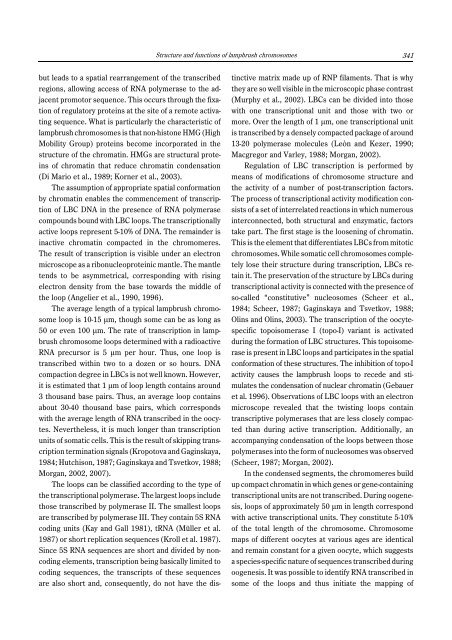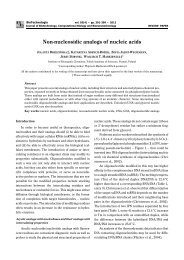Structure and functions of lampbrush chromosomes - BioTechnologia
Structure and functions of lampbrush chromosomes - BioTechnologia
Structure and functions of lampbrush chromosomes - BioTechnologia
Create successful ePaper yourself
Turn your PDF publications into a flip-book with our unique Google optimized e-Paper software.
<strong>Structure</strong> <strong>and</strong> <strong>functions</strong> <strong>of</strong> <strong>lampbrush</strong> <strong>chromosomes</strong> 341but leads to a spatial rearrangement <strong>of</strong> the transcribedregions, allowing access <strong>of</strong> RNA polymerase to the adjacentpromotor sequence. This occurs through the fixation<strong>of</strong> regulatory proteins at the site <strong>of</strong> a remote activatingsequence. What is particularly the characteristic <strong>of</strong><strong>lampbrush</strong> <strong>chromosomes</strong> is that non-histone HMG (HighMobility Group) proteins become incorporated in thestructure <strong>of</strong> the chromatin. HMGs are structural proteins<strong>of</strong> chromatin that reduce chromatin condensation(Di Mario et al., 1989; Korner et al., 2003).The assumption <strong>of</strong> appropriate spatial conformationby chromatin enables the commencement <strong>of</strong> transcription<strong>of</strong> LBC DNA in the presence <strong>of</strong> RNA polymerasecompounds bound with LBC loops. The transcriptionallyactive loops represent 5-10% <strong>of</strong> DNA. The remainder isinactive chromatin compacted in the chromomeres.The result <strong>of</strong> transcription is visible under an electronmicroscope as a ribonucleoproteinic mantle. The mantletends to be asymmetrical, corresponding with risingelectron density from the base towards the middle <strong>of</strong>the loop (Angelier et al., 1990, 1996).The average length <strong>of</strong> a typical <strong>lampbrush</strong> chromosomeloop is 10-15 μm, though some can be as long as50 or even 100 μm. The rate <strong>of</strong> transcription in <strong>lampbrush</strong>chromosome loops determined with a radioactiveRNA precursor is 5 μm per hour. Thus, one loop istranscribed within two to a dozen or so hours. DNAcompaction degree in LBCs is not well known. However,it is estimated that 1 μm <strong>of</strong> loop length contains around3 thous<strong>and</strong> base pairs. Thus, an average loop containsabout 30-40 thous<strong>and</strong> base pairs, which correspondswith the average length <strong>of</strong> RNA transcribed in the oocytes.Nevertheless, it is much longer than transcriptionunits <strong>of</strong> somatic cells. This is the result <strong>of</strong> skipping transcriptiontermination signals (Kropotova <strong>and</strong> Gaginskaya,1984; Hutchison, 1987; Gaginskaya <strong>and</strong> Tsvetkov, 1988;Morgan, 2002, 2007).The loops can be classified according to the type <strong>of</strong>the transcriptional polymerase. The largest loops includethose transcribed by polymerase II. The smallest loopsare transcribed by polymerase III. They contain 5S RNAcoding units (Kay <strong>and</strong> Gall 1981), tRNA (Müller et al.1987) or short replication sequences (Kroll et al. 1987).Since 5S RNA sequences are short <strong>and</strong> divided by noncodingelements, transcription being basically limited tocoding sequences, the transcripts <strong>of</strong> these sequencesare also short <strong>and</strong>, consequently, do not have the distinctivematrix made up <strong>of</strong> RNP filaments. That is whythey are so well visible in the microscopic phase contrast(Murphy et al., 2002). LBCs can be divided into thosewith one transcriptional unit <strong>and</strong> those with two ormore. Over the length <strong>of</strong> 1 μm, one transcriptional unitis transcribed by a densely compacted package <strong>of</strong> around13-20 polymerase molecules (Leòn <strong>and</strong> Kezer, 1990;Macgregor <strong>and</strong> Varley, 1988; Morgan, 2002).Regulation <strong>of</strong> LBC transcription is performed bymeans <strong>of</strong> modifications <strong>of</strong> chromosome structure <strong>and</strong>the activity <strong>of</strong> a number <strong>of</strong> post-transcription factors.The process <strong>of</strong> transcriptional activity modification consists<strong>of</strong> a set <strong>of</strong> interrelated reactions in which numerousinterconnected, both structural <strong>and</strong> enzymatic, factorstake part. The first stage is the loosening <strong>of</strong> chromatin.This is the element that differentiates LBCs from mitotic<strong>chromosomes</strong>. While somatic cell <strong>chromosomes</strong> completelylose their structure during transcription, LBCs retainit. The preservation <strong>of</strong> the structure by LBCs duringtranscriptional activity is connected with the presence <strong>of</strong>so-called “constitutive” nucleosomes (Scheer et al.,1984; Scheer, 1987; Gaginskaya <strong>and</strong> Tsvetkov, 1988;Olins <strong>and</strong> Olins, 2003). The transcription <strong>of</strong> the oocytespecifictopoisomerase I (topo-I) variant is activatedduring the formation <strong>of</strong> LBC structures. This topoisomeraseis present in LBC loops <strong>and</strong> participates in the spatialconformation <strong>of</strong> these structures. The inhibition <strong>of</strong> topo-Iactivity causes the <strong>lampbrush</strong> loops to recede <strong>and</strong> stimulatesthe condensation <strong>of</strong> nuclear chromatin (Gebaueret al. 1996). Observations <strong>of</strong> LBC loops with an electronmicroscope revealed that the twisting loops containtranscriptive polymerases that are less closely compactedthan during active transcription. Additionally, anaccompanying condensation <strong>of</strong> the loops between thosepolymerases into the form <strong>of</strong> nucleosomes was observed(Scheer, 1987; Morgan, 2002).In the condensed segments, the chromomeres buildup compact chromatin in which genes or gene-containingtranscriptional units are not transcribed. During oogenesis,loops <strong>of</strong> approximately 50 μm in length correspondwith active transcriptional units. They constitute 5-10%<strong>of</strong> the total length <strong>of</strong> the chromosome. Chromosomemaps <strong>of</strong> different oocytes at various ages are identical<strong>and</strong> remain constant for a given oocyte, which suggestsa species-specific nature <strong>of</strong> sequences transcribed duringoogenesis. It was possible to identify RNA transcribed insome <strong>of</strong> the loops <strong>and</strong> thus initiate the mapping <strong>of</strong>




